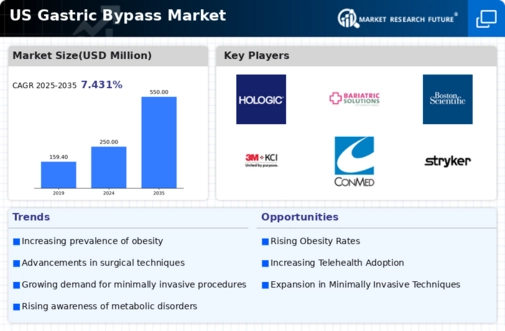Rising Obesity Rates
The increasing prevalence of obesity in the US is a primary driver for the gastric bypass market. According to the CDC, approximately 42.4% of adults were classified as obese in 2017-2018, a figure that has likely risen. This alarming trend has led to a greater demand for surgical interventions, including gastric bypass procedures. As obesity is linked to various comorbidities such as diabetes, hypertension, and cardiovascular diseases, the urgency for effective weight-loss solutions has intensified. The gastric bypass market is responding to this need by expanding its offerings and improving surgical outcomes. Furthermore, the economic burden of obesity, estimated at $147 billion annually, underscores the necessity for effective treatments, thereby propelling the market forward.
Evolving Patient Demographics
The evolving demographics of patients seeking gastric bypass surgery are influencing the market dynamics. An increasing number of younger individuals, including adolescents, are being diagnosed with obesity, prompting a shift in the target demographic for the gastric bypass market. This trend indicates a need for tailored surgical solutions that address the unique challenges faced by younger patients. Additionally, the growing diversity in the patient population necessitates culturally competent care and consideration of varying health beliefs. The gastric bypass market must adapt to these changing demographics by offering personalized treatment plans and support systems. As more individuals from diverse backgrounds seek surgical options, the market is likely to expand, reflecting the need for inclusive healthcare solutions.
Advancements in Surgical Technology
Technological innovations in surgical techniques are significantly influencing the gastric bypass market. Minimally invasive procedures, such as laparoscopic gastric bypass, have gained traction due to their reduced recovery times and lower complication rates. The introduction of robotic-assisted surgeries further enhances precision and patient outcomes. As these technologies become more accessible, the gastric bypass market is likely to experience increased adoption rates among healthcare providers. Moreover, the integration of advanced imaging techniques and surgical simulations is expected to improve preoperative planning and postoperative care. This evolution in surgical technology not only enhances patient safety but also contributes to the overall growth of the gastric bypass market, as more patients seek these advanced treatment options.
Growing Demand for Weight Loss Solutions
The rising demand for effective weight loss solutions is a crucial driver for the gastric bypass market. With a significant portion of the population struggling with obesity, many individuals are turning to surgical options as a viable alternative to traditional weight loss methods. The gastric bypass market is witnessing an increase in patient inquiries and consultations, reflecting a shift in attitudes towards surgical interventions. Additionally, the success rates associated with gastric bypass procedures, which can lead to substantial weight loss and improvement in obesity-related conditions, are encouraging more patients to consider this option. As awareness of the benefits of surgical weight loss continues to grow, the market is poised for further expansion.
Increased Focus on Preventive Healthcare
The growing emphasis on preventive healthcare is shaping the landscape of the gastric bypass market. As healthcare providers and policymakers prioritize preventive measures, there is a heightened awareness of the long-term health implications of obesity. This shift is prompting more individuals to seek surgical interventions as a proactive approach to managing their weight and associated health risks. The gastric bypass market is likely to benefit from this trend, as patients increasingly view surgery as a means to prevent serious health issues rather than merely a cosmetic procedure. Furthermore, the integration of weight management programs and lifestyle modifications alongside surgical options is expected to enhance patient outcomes and satisfaction, thereby driving market growth.
















Leave a Comment